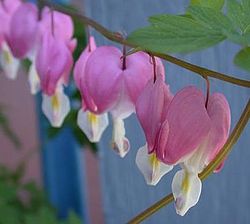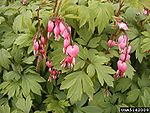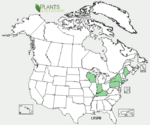Bleeding heart
| Bleeding heart |
|---|

|
| Scientific Classification |
|
| Binomial Name |
|
Lamprocapnos spectabilis |
| Bleeding Heart Close up |
Bleeding Heart is a species of ornamental flowering plants known by the scientific name Lamprocapnos spectabilis. Its name is derived from its pink blossoms that are heart shaped.
They are prolific self-seeders, but can also be propagated by carefully dividing the plant in the spring or fall. Another way to reproduce these lovely plants it by taking young shoots once they have started their spring growth or from taking cuttings off the large, mature plants after they flower.
Once you take the time to properly plant this perennial plant, it takes a minimal amount to keep it growing. If placed in a mostly shady area in the garden it will yield beautiful blooms from early spring to late summer. It will grow up to 18" tall, sometimes a little taller if truly ideal conditions are maintained. You do need to give it's roots room so allow about 1-2 feet between plants. [1]
Anatomy
Several species known as bleeding heart are members of Dicentra, a genus of herbaceous flowering plants of the fumitory family. The Allegheny Mountain region of eastern North America is where the Lamprocapnos spectabilis grow naturally. It produces sprays of small pink flowers from April to September. [2]
Ornamental plant. Height: 6" - 18"
Bloom Color:
Pink
Rose/Mauve
Magenta (Pink-Purple)
Fuchsia (Red-Purple)
Purple
Blooms from mid-spring through summer.
Foliage:
Evergreen
Silver/Gray
Blue-Green
Succulent
Reproduction
The Bleeding heart is a dicot (dicotyledon) flowering plant with two embryonic seed leaves. A dicot is an angiosperm that is not a monocotyledon, having two cotyledons in the seed. They have a taproot and net like veins on their leaves. The Bleeding Heart is a perennial and will be perpetual or be recurrent naturally, season after season. The stems are leafy and grow erect to prostrate.
Ecology
The old fashioned bleeding heart grows best in a partial shaded areas where the soil is not too dry. Although use caution to not over water the plant. It enjoys a soil pH that is slightly alkaline between 7.0-7.5. The bleeding heart can grow and spread out to 2.5 feet while growing upward of 2 feet. The bleeding heart grows well with other similar plants. It can also thrive in a container pot. It is a perennial plant that is easy to grow with minimal attention and can bloom from mid spring to late summer. In the United States it grows in the states of: Connecticut, Indiana, Kentucky, Maine, New York, Pennsylvania and Wisconsin.
It is suggested you mulch during the first winter. Foliage may die back after flowering during the summer months when the weather gets hotter. Ideal soil condition may have peat moss, compost, or dehydrated manure mixed in it. Mulching around the base during the initial winter is good for naturalizing.
ALL PLANT PARTS MAY BE TOXIC IF INGESTED.
Additional Facts
Common Names: Dutchman's trousers, Dutchman's breeches, Lyre Flower, old fashioned bleeding heart, valentine flower and most commonly, the Bleeding heart.
Limited sun or shady areas are the ideal growing conditions for the Lamprocapnos spectabilis. The taller plant can tolerate full sun but won't bloom as much and the leaves may fall off by mid-summer. When temperatures get too high and/or exposed to direct sunlight it will tend to disappear completely until the next spring growing season. Keeping the plant in a shadier, cooler environment will yield richer colors in both flowers and leaves.
Along with a richly fertile, organic soil it also needs to be well-drained. Moist but not drenched soil is ideal. Over watering can lead to root rot. Either over watering or under watering can keep the plant from fully blooming. When planting, take care because the roots can be brittle. The plant can be re-planted but often it will take 2 years after replanting for the plant to produce flowers. Growing Bleeding Heart
Other popular spectabilis plants include the: fringed bleeding heart with pink flowers; gold heart bleeding heart with gold flowers, king of hearts with pink flowers; langtrees bleeding hearts with white flowers; white old-fashioned bleeding heart with pure white flowers. [3]
References
- [4] Brenda Hyde, Old Fashioned Living
- [5] Lorraine Hunter
- Growing Bleeding Heart
- [6]
- [7]



